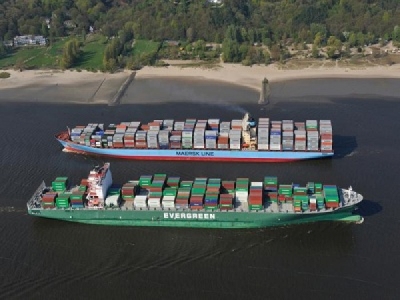
Posted on February 20, 2018
By Greg Knowler, JOC.com
The number of mega-ships calling at the Port of Hamburg more than doubled in 2017, but through a unique set of circumstances, Germany’s busiest port saw its volume actually decline compared with the previous year.
In 2017, Hamburg received 102 calls by vessels in the 18,000 to 20,000-plus TEU class, an increase of 52.2 percent, according to the Port of Hamburg’s marketing organization. It is a trend being reported at other regional gateways, but while its competitors in North Europe reported strongly rising volume in 2017, container throughput at Hamburg fell by 1 percent year over year to 8.8 million TEU.
However, the total number of boxes does not tell the full story. Port of Hamburg Marketing officials believe draft restrictions in force on the Elbe River fairway and the narrow tidal window have caused shipowners to use available transport space on their mega-ships primarily to shift loaded boxes, with empty containers increasingly being routed via other ports in North Europe.
In 2017, the empty containers handled by Hamburg fell by 88,000 TEU to 1.2 million TEU, while loaded boxes remained unchanged at 7.6 million TEU. Hamburg handles the lowest proportion of empty containers among its hub peers at 13 percent of the total, and the highest proportion of loaded boxes at 87 percent.
“Once the [Elbe] fairway adjustment has been completed, we shall be able to handle substantially more containers and bulk cargo in Hamburg. Terminals and other port facilities are well prepared for growth,” said Port of Hamburg Marketing executive board member Ingo Egloff.
“Increased draft on the Elbe and simplification of maneuvering by the construction of a passing zone on the Elbe downstream from Hamburg will facilitate more efficient use of hold capacities and crucially simplify passing for ultra-large vessels.”
The importance of deepening the Elbe draft was strongly highlighted by the port, which is confident a start on the deepening works will finally be made this year. Environmental opposition to deepening the Elbe River has been holding up plans to dredge about 130 kilometers (81 miles) of the river that, once complete, will enable the mega-ships with a draught of 14.5 meters to reach the port, one meter deeper than the current draught. But in November 2017, a German court dismissed a legal challenge to the planned dredging, clearing the way for the project.
While Hamburg struggles to grow its container throughput, the port of Gdansk in neighboring Poland is having no such trouble. In 2017, Gdansk saw volume rise by 24 percent to 1.6 million TEU, as the port benefits from direct calls by the world’s two largest alliances, 2M and the Ocean Alliance. Gdansk extended its relationship with the 2M Alliance and began receiving calls from the Ocean Alliance from May.
The Polish port has made significant investments recently with the opening of its second container terminal, which will receive new and larger cranes in the third quarter of 2018; the main gate will be automated and rail infrastructure improved.
Cameron Thorpe, CEO of DCT Gdansk, said over the next two years, a second fairway approach will be made to the port that DCT will have access to.
“This will further reduce the time from pilot-station to berth, enhancing the total port turn-around time of the ultra-large container vessels calling,” he said. “Longer term, DCT has considerable ability to expand both berth and yard footprint, so we can effectively continue to grow in-line with market demand.”
Source: JOC.com





